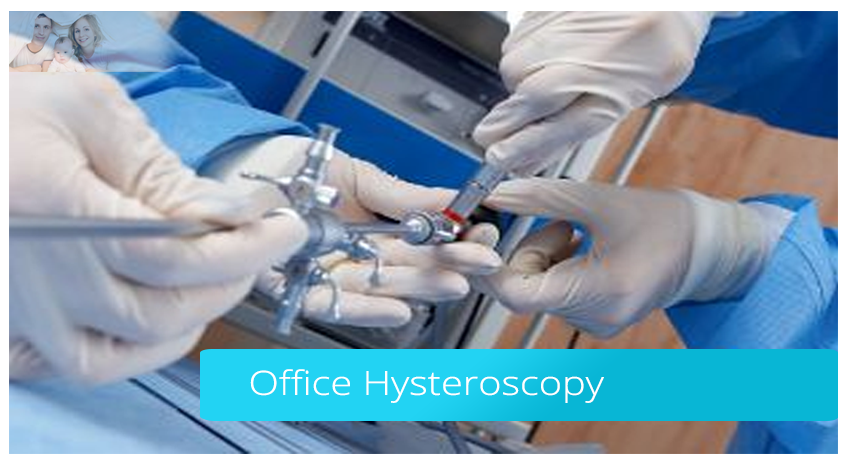Hysteroscopy is called office hysteroscopy. Office hysteroscopy uses very thin instruments that can be easily inserted into the uterus without expanding the cervix.
What is Office Hysteroscopy?
Office Hysteroscopy is a very comfortable, easy and important procedure performed in the office or clinic environment, which usually does not require any anesthesia and allows the imaging of the uterus with a camera.
Name of the method; it is derived from the terms hysterorrhoea, scopy-imaging, which may be in the office. Sometimes the abbreviation Office H / S is used.
The aim is to evaluate the complete uterine cavity (uterine cavity), which is also called as progeny. So office hystero is a direct method, not indirect like HSG (medicated film).
How Office Hysteroscopy is performed?
In office hysteroscopy, as in laparoscopy, an optical system called telescope is used; but its diameter is much thinner (therefore painless). The diameter used for diagnostic purposes is 5 mm. Without dilatation to the cervix, the procedure is performed in the gynecological examination position.
CO2 or some special fluids are introduced through the cervix through the hysteroscope, so that the walls of the uterus are separated. Hysteroscopy allows the visualization of the structures inside the enlarged uterus directly.
Office Is hysteroscopy a painful procedure?
Diagnostic hysteroscopy is usually performed without the need for anesthesia or hospitalization with local anesthesia. According to many people, it is a much more painless diagnostic method than medicated film.
When should Office Hysteroscopy be performed?
For easier evaluation of the uterus, it is often necessary to administer it within a few days after the end of menstruation. As the intrauterine membrane thickens as menstrual period progresses, diagnosis is difficult.
Although office hysteroscopy was initially used for diagnosis only, it has become used in the treatment of many abnormalities seen in the uterus in recent years.
Office hysteroscopy is mostly used for abnormal bleeding, evaluation of infertility, intrauterine adhesion, and removal of small fibroids and polyps.
With office hysteroscopy, it is also possible to cut the innate curtains or walls in the uterus called the septum.
Office hysteroscopy is also used to remove intrauterine devices (spirals) that have escaped the cord into the uterus.
In office hysteroscopy, the patient is first given a light intravenous sedative, and then the hysteroscope is inserted into the uterus without inserting an instrument (speculum) into the vagina, holding the cervix and dilating it.
A slight cramp may be felt during hysteroscopy insertion into the uterus. After entering into the uterus, the cavity is inflated by giving water and observed on the video screen.
Office hysteroscopy is extremely useful in the diagnosis of abnormal bleeding before and after menopause.
Polyps, fibroids, or tumors in the uterus are easily seen by hysteroscopy. Some of these can be taken by hysteroscopy. Some may require anesthesia and a larger hysteroscopy or a larger operation.
Hysteroscopy is a very important method in the evaluation of infertility. Lesions or adhesions in the uterus may be the cause of infertility and a significant number of them can be treated by hysteroscopy.
It is important to confirm that the uterine cavity is normal by hysteroscopy, especially in women without uterine film, prior to IVF treatment.
Hysteroscopy is even more important, especially in couples with previous unsuccessful trials. In some studies, hysteroscopy shows abnormalities in the uterine cavity by 50% in patients with previous 2 or more IVF failures.
The most important of these are endometritis, polyps, adhesions and septum which does not extend deeply.
With the treatment of these abnormalities, pregnancy rates can be normalized in subsequent IVF applications.
During which period of hysteroscopy is performed?
Hysteroscopy should ideally be performed immediately after the end of menstruation. During this period, the inner layer of the uterus is thin and intrauterine abnormalities can be seen more clearly.
What should I do before hysteroscopy?
If general anesthesia is to be given before hysteroscopy, a 6-hour fasting (food and drink) period is required. In office hysteroscopy, a shorter hunger is sufficient.
Does pain or bleeding occur after hysteroscopy?
Generally, the pain is extremely low or absent. Bleeding is usually dripping and lasts a short time.
What are the complications of hysteroscopy?
The main procedure-related complications of hysteroscopy are uterine perforation (laparoscopy may need to look and repair), bleeding (uterine catheter may be needed), tear of the cervix (repaired by suture), and intra-uterine adhesion development after removal of large and near-segment fibroids. These are found around 1%. The diagnosis and treatment of complications are relatively easy for experienced hysteroscopists.


Add Your Comment